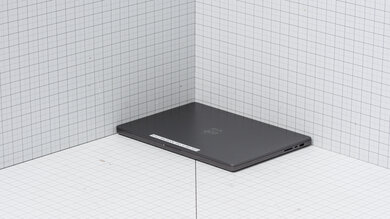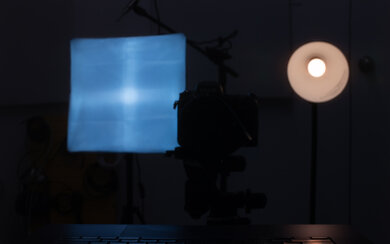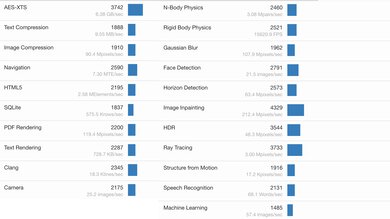The Apple MacBook Pro 16 (M3, 2023) is a 16-inch premium workstation laptop. It replaces the M2 Apple MacBook Pro 16 from early 2023. Except for the new Space Black color, this late 2023 model is identical in design to its M2 predecessor. The M3 Pro/Max SoCs bring increased memory support (up to 128GB) as well as features like hardware-accelerated ray tracing and AV1 decoding. It has the same but slightly brighter 120Hz ProMotion Liquid Retina XDR display. Its port selection remains the same with three USB-C/Thunderbolt 4s, an HDMI 2.1, a full-size SD card reader, a 3.5mm headphone jack, and a MagSafe charging port.
You can see our unit's specifications and the available configuration options in the Differences Between Variants section.
Our Verdict
The Apple MacBook Pro 16 2023 is excellent for school use. It feels exceptionally well-built thanks to its full-aluminum chassis, and its battery lasts easily through a typical school day with plenty of charge to spare. Its 16-inch display gives you plenty of room for multitasking and gets bright enough to combat glare, even in well-lit settings. The keyboard feels great to type on, and the touchpad is large and responsive. Its M3 Pro/Max SoCs can handle nearly any workload, making it suitable for students in fields like graphic design or 3D animation. It isn't overly bulky for a 16-inch laptop but is fairly heavy.
- Not overly bulky for a 16-inch laptop.
- All-day battery life.
- M3 Pro/Max SoCs can handle demanding workloads.
- Comfortable keyboard and large, easy-to-use haptic touchpad.
- Wide port selection with Thunderbolt 4 and HDMI 2.1.
- No USB-A ports.
The Apple MacBook Pro 16 2023 has enough processing power to run demanding games; however, very few games are optimized for its ARM-based SoC, and running games through Rosetta 2 can result in poor performance or graphical glitches, depending on the game. Also, the display's response time is quite slow even though it has a 120Hz refresh rate, resulting in noticeable ghosting in fast-moving scenes. On the upside, its SoC doesn't throttle under load, and the laptop doesn't get hot or loud.
- M3 Pro/Max SoCs can handle demanding workloads.
- Wide port selection with Thunderbolt 4 and HDMI 2.1.
- Minimal performance loss under load.
- 120Hz display.
- RAM and storage aren't user-replaceable.
- Display has slow response time.
The Apple MacBook Pro 16 M3 is great for media consumption. It has a large, sharp, and colorful display that gets bright enough for a true HDR experience, and thanks to its Mini LED backlight, it can display deep, inky blacks, making it fantastic for dark room viewing. The speakers get very loud and sound full and well-balanced with a good amount of bass. Battery life is outstanding at nearly 13 hours of video playback, enough time to get through multiple full-length movies and TV show episodes. Portability is so-so; it isn't overly bulky for a 16-inch device but is fairly heavy.
- Not overly bulky for a 16-inch laptop.
- All-day battery life.
- Sharp, bright display with high contrast, 100% DCI P3 coverage, and superb factory calibration.
- Speakers get very loud.
- Full-sounding speakers with a good amount of bass.
- Display doesn't support touch input.
The Apple MacBook Pro 16 M3 is an outstanding workstation. Its M3 Pro/Max SoCs can handle even the most demanding workloads, including tasks like programming, video editing, Al development, and 3D rendering. Additionally, it has a sharp display with full DCI P3 coverage and superb calibration, making it suitable for color-critical work. Its excellent port selection includes a full-size HDMI, three USB-Cs/Thunderbolt 4s, and an SD card reader, so you can easily connect peripherals and external displays. It doesn't throttle under load, and while its fans are audible, they aren't overly distracting. The only downside is that the memory and storage aren't user-replaceable.
- M3 Pro/Max SoCs can handle demanding workloads.
- Comfortable keyboard and large, easy-to-use haptic touchpad.
- Sharp, bright display with high contrast, 100% DCI P3 coverage, and superb factory calibration.
- Wide port selection with Thunderbolt 4 and HDMI 2.1.
- Minimal performance loss under load.
- RAM and storage aren't user-replaceable.
The Apple MacBook Pro 16 M3 is excellent for business use. It has a large, bright display, a comfortable keyboard, a gigantic haptic touchpad, and an excellent 1080p webcam. Its wide port selection includes a full-size HDMI and three USB-C/Thunderbolt 4s, so you can easily connect peripherals or an external display for presentations. Apple's M3 Pro/Max SoCs can easily handle tasks like text processing, web browsing, spreadsheets, and presentations, and thanks to its power-efficient design, the battery lasts easily through a typical 8-hour day with plenty of charge to spare. Portability-wise, it isn't overly bulky for a 16-inch device, but it's on the heavier side.
- Not overly bulky for a 16-inch laptop.
- All-day battery life.
- Comfortable keyboard and large, easy-to-use haptic touchpad.
- Outstanding 1080p webcam.
- Wide port selection with Thunderbolt 4 and HDMI 2.1.
- RAM and storage aren't user-replaceable.
- No USB-A ports.
Changelog
- Updated May 07, 2025: We've updated this review to Test Bench 0.8.3, which removes the viewing angle tests and adds a GPU Total Graphics Power comparison in the GPU section. The Pen Input test in the Extra Features section has also changed, as it now shows whether the laptop supports pen input rather than the inclusion of a stylus in the box. See the changelog for more details.
- Updated Sep 16, 2024: Added mention of the Dell Precision 5690 (2024) as a Windows alternative with more powerful GPU options for professional workloads in the GPU section.
- Updated Jul 26, 2024: We've retested the speakers, as we've mistakenly posted results from the Apple MacBook Pro 16 (2019). The M3 model's speakers sound more well-balanced, with slightly more bass, but don't get as loud.
- Updated Dec 18, 2023: Review published.
Differences Between Sizes And Variants
We tested the Apple MacBook Pro 2023 with an M3 Max SoC (16-core CPU, 40-core GPU), 48GB of RAM, and 1TB of storage. The SoC, RAM, and storage are configurable; the available options are in the table below.
| Screen |
|
|---|---|
| SoC |
|
| Memory |
|
| Storage |
|
| Color |
|
You can see our unit's label here.
Popular Laptop Comparisons
The Apple MacBook Pro 16 2023 is one of the best laptops on the market. It stands out for its exceptional build quality, as well as the quality of its display, touchpad, speakers, and webcam. Although there are faster CPUs and GPUs on the market, none are as power-efficient as Apple's in-house SoCs. Their efficiency gives the MacBook Pro a longer battery life than almost any other high-performance workstation.
For more options, check out our recommendations for the best workstation laptops, the best video editing laptops, and the best laptops for graphic design.
The Apple MacBook Pro 16 (M4, 2024) is the next generation of the Apple MacBook Pro 16 (M3, 2023). Both devices share outstanding build quality and provide an industry-leading user experience. Notable changes include a new nano-texture Liquid Retina XDR display with superior reflection handling and the M4 Pro and Max SoCs. These new SoCs are significantly faster in both productivity and gaming workloads and feature significantly increased memory bandwidth. Finally, you get Thunderbolt 5 support on the newer model.
The Apple MacBook Pro 16 (M3, 2023) is a newer version of the Apple MacBook Pro 16 (M1, 2021). Except for a new Space Black color, they're identical in design, as all the improvements are internal. The M3 MacBook Pro 16 has a slightly brighter display, better performance, and longer battery life. The M3 Pro/Max SoCs also add hardware-accelerated ray tracing, AV1 decoding, and increased memory support (up to 128GB).
Although the Apple MacBook Pro 16 (M3, 2023) and the ASUS ROG Zephyrus G16 (2024) GU605 are both high-performance 16-inch laptops, they're very different in their intended use, as the MacBook Pro is a workstation designed for intensive tasks like video editing and 3D graphics, while the ASUS is a primarily a gaming laptop. The ASUS can also handle professional workloads, as it has a good amount of processing power (especially on the GPU side); however, it still lags behind the MacBook Pro in CPU performance, as its Intel Meteor Lake CPUs aren't quite as fast as Apple's top-end M3 Max SoC. Another notable difference between these two laptops is battery life; Apple's M3 SoC is far more efficient, giving the MacBook Pro around 13 hours of battery life in light uses compared to the ASUS laptop's six to seven hours.
The Apple MacBook Pro 16 (M3, 2023) is much better than the Apple MacBook Air 15 (M3, 2024) for most uses. The MacBook Pro is a much more powerful device designed for demanding workloads like content creation, while the MacBook Air is an ultraportable designed for general productivity tasks. While both devices sport a nice display, the MacBook Pro's is much more advanced, as it has a Mini LED backlight, allowing for local dimming, and it gets significantly brighter, up to 1600 cd/m² in HDR. It also has a 120Hz refresh rate (60Hz on the MacBook Air), improving motion smoothness and system responsiveness. Other improved features on the MacBook Pro include a wider port selection with better multi-display support, better-sounding, up-firing speakers, and a better active cooling system, allowing for better performance in heavy, sustained workloads.
Test Results

The Apple MacBook Pro 16 M3 resembles the first Apple-silicon Apple MacBook Pro 16 (2021). It has a sleek, premium design with a somewhat boxy aluminum chassis, thin bezels, a centered notch, up-firing speakers on each side of the keyboard, and a gigantic glass touchpad. The vents are on the bottom and at the back of the laptop. You can still get this laptop in Silver, but Apple has retired the Space Gray color on the 16-inch model and replaced it with Space Black, which is just a darker gray.
This laptop's build quality is exceptional and is considered by many to be the gold standard in the laptop industry. It has a sturdy all-aluminum chassis that exhibits little to no flex, with a finish that doesn't scratch easily. The new Space Black color supposedly has a more smudge-resistant coating; it still picks up fingerprints and smudges, just less than other dark-color finishes. The hinges, feet, and glass touchpad feel solid. The whole device feels hefty, with evenly distributed weight. The only common complaint is that the keycaps pick up oil and smudges very easily and develop a shine within only a few months of regular use.
The Apple MacBook Pro laptop is fairly heavy. It isn't overly bulky for a 16-inch device, but it's a 16-inch device nonetheless and likely won't fit into smaller bags. Thankfully, the power adapter is compact and lightweight.
The Apple MacBook Pro laptop's serviceability is bad, as only the battery is replaceable. On the upside, accessing the internals doesn't take too much effort. Like previous MacBook Pros with Apple silicon, you only need to remove eight P5 screws, pry the panel open with a tool, pull the panel towards the bottom of the laptop, and then upwards to remove it.
The Apple MacBook Pro laptop's Liquid Retina XDR display looks remarkably sharp. Its 16:10 aspect ratio is great for productivity, as it gives you more vertical space than a standard 16:9 screen, allowing you to see more information when reading a document without having to scroll. The downside is that you'll almost always have black bars at the top and bottom when watching standard 16:9 videos. The notch doesn't actually cut into the 16:10 display; Apple added extra space beside the notch to house the menu bar. You can hide the notch if it bothers you, though you'd lose the space beside it.
The Apple MacBook Pro's display supports ProMotion, meaning its refresh rate can ramp up to 120Hz depending on the task or content on the screen, similar to VRR. This adaptive technology makes motion appear smoother and the system more responsive, but it also helps extend battery life when the content on the screen is inactive. It works like other VRR technologies; however, the application needs to support it to be functional. It's worth noting that you can't set the refresh rate to a fixed 120Hz as there's only a 'ProMotion' setting for any refresh rate above 60Hz. Unfortunately, the response time is quite slow, resulting in visible ghosting behind fast-moving objects.
The Apple MacBook Pro has a superb contrast ratio thanks to its Mini LED backlight (10,000 Mini LEDs). Blacks look deep and inky, making it well-suited for dark rooms and for viewing HDR content. You may see some blooming around bright objects because the Mini LED backlight doesn't have pixel-level control like OLED panels.
The Apple MacBook Pro laptop's display brightness is outstanding. It gets bright enough to combat glare in most settings, even outdoors in broad daylight, though you may have some trouble seeing darker content in direct sunlight. The screen also gets very dim to provide a more comfortable viewing experience in dark rooms.
The display does get up to 1600 cd/m² in HDR, as Apple claims. Here are the results at various window sizes.
HDR Brightness:
- 2% Peak: 1481.2 cd/m²
- 2% Sustained: 1475.3 cd/m²
- 10% Peak: 1632.8 cd/m²
- 10% Sustained: 1629.9 cd/m²
- 25% Peak: 1641.7 cd/m²
- 25% Sustained: 1628.5 cd/m²
- 50% Peak: 1607.6 cd/m²
- 50% Sustained: 1599.4 cd/m²
- 100% Peak: 1191.8 cd/m²
- 100% Sustained:1188 cd/m²
The Apple MacBook Pro laptop's reflection handling is excellent. Its glossy finish only struggles with direct reflections, so it's best to avoid having bright lights directly behind you, as these reflections are visible even with the screen at maximum brightness.
The Apple MacBook Pro laptop's out-of-the-box accuracy is superb. The white balance and color inaccuracies are extremely minor and hard to spot. The color temperature is on the cooler side, but only by a small amount, not enough to make much difference visually. The gamma is pretty good; it's just a little too dark in dark scenes. This level of accuracy is suitable for color-critical work like photo and video editing.
The Apple MacBook Pro laptop's color gamut is outstanding. It has full sRGB coverage, meaning it can display all the colors used in most online content. It also has full DCI P3 coverage, making it suitable for viewing and producing HDR content. Its Adobe RGB coverage is excellent, but it might not be wide enough for professional print photography, as it's missing the saturated greens that define Adobe RGB.
The Apple MacBook Pro laptop has a great keyboard. The layout feels spacious and is exactly like all other MacBooks, so it won't take long to get used to it if you've used a Mac before. The keys are stable, don't require much force to actuate and provide good tactile feedback. The travel distance is quite short, which some people might not like, as when combined with the keyboard deck's stiffness, it can feel like typing on a very hard surface and cause fatigue over time, especially if you're a heavy typer. Typing noise is very low and isn't a problem in quiet environments. You can adjust the backlight brightness via the control panel or system settings.
The Apple MacBook Pro laptop's touchpad is outstanding. It's large, responsive, and easy to use. It tracks all movements and gestures well, and there's no issue with palm rejection. Like other MacBooks, it uses a haptic engine to simulate the clicks instead of physical buttons, allowing you to click anywhere on the touchpad. This is easily among the best touchpads on the market.
The Apple MacBook Pro laptop has excellent speakers. They get pretty loud with minimal compression artifacts at high volume levels, and they sound full and natural, with a good amount of bass. Like the touchpad, these speakers are among the best on the market.
The Apple MacBook Pro laptop's webcam is outstanding. The image looks detailed and well-exposed, with true-to-life colors. Voices sound loud and clear over the microphone, with no background noise.
The Apple MacBook Pro laptop's port selection is excellent. All three USB-C ports support Thunderbolt 4 (up to 40Gbps data transfer rate and two 4k displays at 60Hz), USB4, charging, and DisplayPort. External monitor support changes depending on the SoC. The M3 Pro supports up to two 6k displays at 60Hz over Thunderbolt, or one 6k 60Hz display over Thunderbolt and one 4k 144Hz display over HDMI. Alternatively, it can support one 8k 60Hz or 4k 240Hz display over HDMI. The M3 Max supports up to three 6k displays at 60Hz over Thunderbolt and one 4k 144Hz display over HDMI or two 6k 60Hz displays over Thunderbolt and one 4k 240Hz (or 8k at 60Hz) over HDMI.
We can't confirm the exact model of the wireless adapter. Wi-Fi 6E has faster speeds, lower latency, and less signal interference than previous Wi-Fi standards. However, you need a router that supports Wi-Fi 6E to benefit from these features.
The Apple MacBook Pro laptop is available with the following SoCs:
- M3 Pro 12-core CPU, 18-core GPU, 150GB/s memory bandwidth
- M3 Max 14-core CPU, 30-core GPU, 300GB/s memory bandwidth
- M3 Max 16-core CPU, 40-core GPU, 400GB/s memory bandwidth
All three SoCs (System-on-Chip) can handle demanding tasks like video editing, programming, and 3D graphics, so the choice depends on how smooth an experience you expect and how fast you want to complete tasks. Compared to their M2 Pro/Max predecessors, the changes include increased memory support (up to 128GB), faster performance, and the addition of hardware-accelerated ray tracing and AV1 decoding. The latter helps improve performance and conserve battery when watching AV1-encoded videos like on YouTube and Netflix. One notable change is the reduction in memory bandwidth; the M3 Pro has a 50GB/s reduction (compared to the M2 Pro), while the M3 Max chip with a 14-core CPU has a 100GB/s reduction. Whether these memory bandwidth reductions are noticeable in actual use depends entirely on your workload. If you have memory-intensive tasks involving Machine Learning or anything that requires large data sets, it's probably best to get an M3 Max model.
The Apple MacBook Pro laptop uses integrated graphics. You can't change the GPU configuration without changing the CPU portion of the SoC. The M3 Pro/Max's GPU can handle demanding tasks; the choice depends entirely on your workload. You can play graphically intensive games, but the performance will rely heavily on the game itself, as few games run natively on Apple silicon. If you're open to a Windows workstation and need more powerful GPU options for professional workloads, consider the Dell Precision 5690 (2024).
This laptop is available with 16GB, 32GB, 64GB, or 96GB of RAM. However, there are limitations to the configuration. The M3 Pro model is configurable with 18GB or 36GB, while the M3 Max model with a 30-core GPU is configurable with 36GB or 96GB. The top-end M3 Max model with a 40-core GPU is configurable with 48GB, 64GB, or 128GB.
You can configure this laptop with 512GB, 1TB, 2TB, 4TB, or 8TB of storage. The storage isn't user-replaceable.
The Apple MacBook Pro laptop with an M3 Max (16-core GPU) SoC performs exceptionally well in the Geekbench 5 benchmarks. It can handle nearly every type of workload, including light productivity tasks like text processing and web browsing and more demanding workloads like programming and AI development. The GPU is also well-suited for intensive tasks. The GPU compute score may seem low compared to Windows laptops with a discrete GPU, but keep in mind that the media engines do most of the heavy lifting in tasks that can utilize them, so it isn't fully representative of the SoC's performance.
The overall score in Cinebench R23 is superb. The M3 Max SoC with 16 CPU cores has no problems handling intensive, multi-threaded applications and heavy multitasking. The M3 Pro with 12 CPU cores and the M3 Max with 14 CPU cores have the same single-thread performance but will be slower in multi-threaded workloads.
The Apple MacBook Pro 2023 is well suited for Blender work. The M3 Pro/Max SoC can easily handle demanding 3D rendering tasks. Unfortunately, we couldn't get the GPU render time, as there wasn't an option to use GPU rendering in Blender.
The top-end M3 Max SoC with a 40-core GPU scores remarkably well in the Basemark GPU benchmark. The score is in the same ballpark as an NVIDIA GeForce RTX 4050 Laptop GPU, an entry-level graphics processor; however, real-world performance will likely be very different, as gaming performance on a Mac depends heavily on each game's optimization.
The storage drive performance is outstanding. Its fast read and write speeds allow the system to quickly boot up, launch apps, and transfer files. The sequential read speed is lower than expected but still very fast. The larger-capacity drives are likely faster, as SSD speeds typically increase with storage size.
The Apple MacBook Pro laptop's battery life is outstanding. It lasts easily through a typical workday of light use on a full charge, maybe even two days, if you take measures to prolong the battery life, like lowering the screen brightness or turning on Low Power Mode. You can expect roughly the same battery life as when gaming if you have a more intensive workload that stresses the CPU and GPU. Models with fewer CPU and GPU cores will likely have slightly longer battery life.
Borderlands 3 runs reasonably well at 1080p on the Apple MacBook Pro 2023 with an M3 Max SoC (40-core GPU). You can get over 60 fps with High settings, but there are noticeable stutters due to frame drops. Turning down the graphical settings doesn't improve performance significantly. The M3 Pro SoC will only get to 60 fps with low settings.
Every configuration of the Apple MacBook Pro 16 2023 can run Civilization VI smoothly; you just have to lower the graphical settings a bit on models with an M3 Pro or M3 Max (30-core GPU) if 60 fps is a must. The average turn time is okay, though this may be the result of having to run the game via Rosetta 2 since the game doesn't support Apple silicon.
Counter-Strike 2 doesn't run on macOS, as Valve has discontinued support.
Shadow of the Tomb Raider runs very well on the Apple MacBook Pro laptop with an M3 Max SoC (40-core GPU). The gameplay is smooth, with only a few occasional stutters. The M3 Pro SoC can handle this game, but you'll have to lower a couple of settings to get over 60 fps.
The keyboard deck is cool when idle and only gets mildly warm under load, not enough to cause discomfort by any means. The fans are fairly loud under load, but the noise isn't overly annoying or bothersome.
The Apple MacBook Pro 16 M3's performance over time is superb. Neither the CPU nor the GPU throttles under load.
The Apple MacBook Pro 2023 ships with macOS Sonoma. There aren't any pre-installed applications other than those that typically come with macOS.
The Apple MacBook Pro 16 M3 has a fingerprint sensor built into the power button at the top right corner of the keyboard. You can use it to log in quickly, as well as authorize purchases in the App Store and payments via Apple Pay.



























